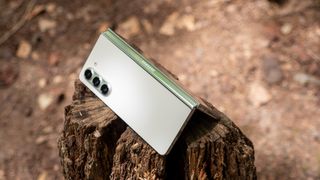Past the Alphabet
Past the Alphabet is a weekly column that focuses on the tech world each in and out of the confines of Mountain View.
As somebody who used to downright keep away from Samsung telephones in any respect prices, I discover it completely wild to see the turnaround that is occurred. Whereas the TouchWiz period nonetheless invokes a way of cringe at any time when I give it some thought, Samsung has managed to utterly flip its software program round, particularly in relation to updates.
In late March, Samsung began rolling out One UI 6.1, together with a lot quite a lot of bug fixes. As an alternative, this was the replace to put in for these utilizing 2023 flagships, such because the Galaxy S23 or Galaxy Z Fold 5. That is as a result of Samsung introduced lots of the AI options launched with the Galaxy S24 Extremely to those older gadgets, with rumors that they might even come to the Galaxy S22 sequence.

However that is not what shocked me essentially the most in regards to the rollout. It was the truth that each single system on the checklist bought the replace at across the identical time. After seeing the information, I grabbed my Galaxy Z Fold 5 and Tab S9 Extremely, checked for an replace, and sat again as each gadgets downloaded and put in their respective updates.
To not point out that the Galaxy S24 acquired a separate replace on the identical time, simply with a concentrate on digital camera enhancements, and Samsung’s smartwatches additionally acquired updates, with the Galaxy Watch 5 sequence receiving a number of enhancements.
That is the dream that we have been hoping to see from Google, Samsung, and different OEMs. At any time when Apple releases a brand new replace, more often than not, the iPhone, iPad, and Apple Watch all get an replace concurrently. Nonetheless, we have been coping with staggered replace releases on the most effective Android telephones for years.
It positively provides extra credence to the concept Samsung is morphing into the Apple of the Android area. Updates are all arriving collectively, new options are continually arriving in a single kind or vogue, and the corporate is making efforts to supply a cohesive ecosystem. All of the whereas, Google nonetheless appears to be falling a bit in need of what we anticipate.

That is to not say Google is horrible with its updates. Positive, if it weren’t for Google, Samsung’s working system would most likely look lots totally different than it does. In any case, One UI is “only a pores and skin” sitting atop the underlying Android platform. This clearly provides Samsung the power to concentrate on bettering One UI and implementing new APIs or options when Google provides them to Android (and even earlier than Google can).
I can not assist however really feel as if Google is shedding its grip somewhat, although the corporate’s cellphone division continues to see progress. The one proof that you just want is to see what occurred with Gemini Nano. When initially launched, a Google exec said that the Gemini Nano-powered AI options had been restricted to the Pixel 8 Professional. Many, myself included, wished to know why the Pixel 8 wasn’t going to be getting any of these options regardless of the Pixel 8 and eight Professional largely sharing the identical underlying {hardware}.

On the time, Google defined that it was on account of “{hardware} limitations.” However once more, that did not make any sense, given the {hardware} that was shared between the 2 gadgets. Lo and behold Google ultimately revealed that Gemini Nano will come to the Pixel 8, albeit “as a developer possibility with the subsequent Pixel Function Drop,” and even then, the announcement got here a lot later. In the meantime, Gemini Nano has already been obtainable on the Galaxy S24 sequence, together with the smallest mannequin with 8GB or RAM.
Then there’s the continuing debacle with the Pixel Fold, which is seeing not one of the Gemini Nano options. That is a $1,800 cellphone that is not able to offering the identical consumer expertise as one which prices $1,100 much less. It wasn’t till this week that Google even introduced the Circle to Search function to the Pixel Fold and Pixel Pill, and that is not even to say the delays seen with earlier updates on Pixel fashions in recent times.
This does not precisely instill confidence that Google will truly have the ability to comply with by on its seven-year promise for software program updates in any significant means if it might probably’t totally decide to giving us the identical options on current-gen {hardware}. Setting apart the variations between Tensor and Snapdragon, I am extra assured with Samsung’s capacity to comply with by than Google’s.
Whereas I do imagine it was the proper transfer by Google, I can not assist however really feel as if the distinction between the Pixel 8 and Galaxy S24 in seven years might be night time and day. Perhaps I am improper right here, and I hope I’m, but it surely’s turning into extra obvious that one thing is awry in Mountain View.
All of that’s to say that I can not assist however really feel as if the software program facet of Google, , Android, feels a bit damaged. This can be a actual disgrace, contemplating how nice the {hardware} appears to be, even when it does not actually maintain up after a few years.

At this level, it nearly feels as if Google wants one other “reset yr,” like we noticed when the Pixel 6 was launched. The corporate must get the {hardware} and software program groups on a degree taking part in area in order that the ecosystem can proceed to mature and develop with out customers operating into limitations and delays.
If Google needs to proceed to see progress and change into a worthy different to Samsung and Apple, notably within the U.S., one thing has to offer. We have handled fragmentation for years, however we have reached the purpose of placing the blame on Google and never the OEMs. For a corporation price a lot cash, it is actually mind-boggling to see.




















